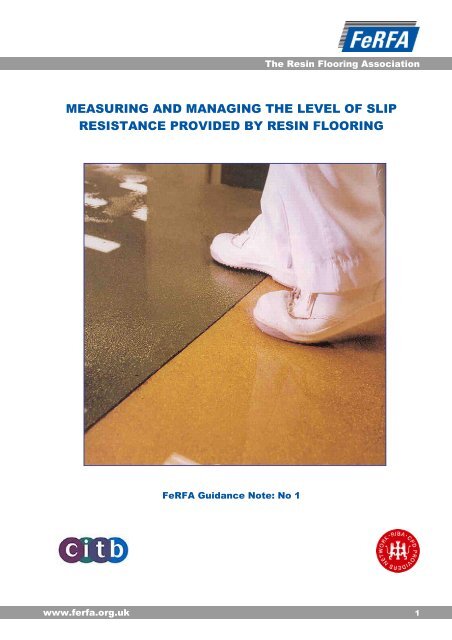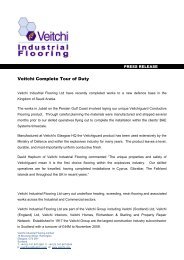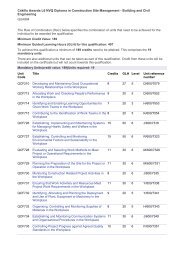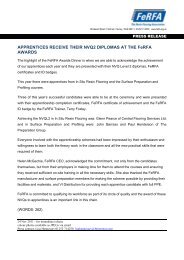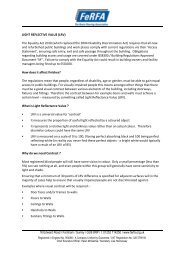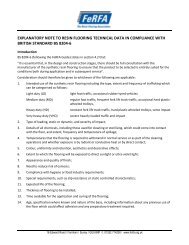Measuring and Managing the Level of Slip Resistance ... - FeRFA
Measuring and Managing the Level of Slip Resistance ... - FeRFA
Measuring and Managing the Level of Slip Resistance ... - FeRFA
You also want an ePaper? Increase the reach of your titles
YUMPU automatically turns print PDFs into web optimized ePapers that Google loves.
The Resin Flooring Association<br />
MEASURING AND MANAGING THE LEVEL OF SLIP<br />
RESISTANCE PROVIDED BY RESIN FLOORING<br />
<strong>FeRFA</strong> Guidance Note: No 1<br />
www.ferfa.org.uk 1
The Resin Flooring Association<br />
1. INTRODUCTION<br />
Correctly specified <strong>and</strong> applied syn<strong>the</strong>tic resin flooring is well proven as an effective method <strong>of</strong> protecting substrates<br />
<strong>and</strong> providing excellent levels <strong>of</strong> slip resistance in wet, dry <strong>and</strong> contaminated conditions, especially within high risk<br />
areas such as food <strong>and</strong> drink processing, commercial catering <strong>and</strong> heavy industrial environments.<br />
Pre-planning at <strong>the</strong> design stage to evaluate <strong>the</strong> environment <strong>and</strong> <strong>the</strong> use <strong>of</strong> <strong>the</strong> floor is critical. The following criteria<br />
should be examined before proceeding with <strong>the</strong> design <strong>of</strong> <strong>the</strong> floor, to ensure <strong>the</strong> causes <strong>of</strong> slips are minimised.<br />
Operating environment (type, concentration <strong>and</strong> frequency <strong>of</strong> likely spillage / contaminant)<br />
Surface regularity (i.e. does <strong>the</strong> floor ‘free drain’ or does st<strong>and</strong>ing water accumulate ?)<br />
Insitu drainage <strong>and</strong> / or new drainage requirements<br />
Regular cleaning procedures<br />
Safety footwear<br />
While processes designed to avoid spillage / contamination is one essential part <strong>of</strong> any slip risk management<br />
approach, it is inevitable that occasions will arise when slippery conditions will occur <strong>and</strong> reliance will be placed on<br />
<strong>the</strong> floor finish to minimise risk. As such, it is essential that floors are designed to h<strong>and</strong>le <strong>the</strong> extremes <strong>of</strong> operating<br />
conditions to minimise risk <strong>and</strong> fully meet duty <strong>of</strong> care responsibilities.<br />
This guidance note will explain <strong>the</strong> main methods for measuring <strong>the</strong> level <strong>of</strong> slip resistance <strong>of</strong>fered by a resin floor<br />
finish in line with <strong>the</strong> main methods recognised in <strong>the</strong> UK. It will <strong>the</strong>n briefly cover o<strong>the</strong>r factors that help manage<br />
<strong>and</strong> minimise <strong>the</strong> overall risk <strong>of</strong> a slip related incident.<br />
2. MEASURING THE LEVEL OF SLIP RESISTANCE PROVIDED BY RESIN FLOORING<br />
As with any basic measure <strong>of</strong> performance, regardless <strong>of</strong> industry, most countries will have <strong>the</strong>ir own opinions <strong>and</strong><br />
approved st<strong>and</strong>ards / methods by which performance should be assessed. Across Europe, <strong>the</strong>re are a number <strong>of</strong><br />
test methods that architects <strong>and</strong> specifiers refer to, but <strong>the</strong>re are only 2 that are formally recognised in <strong>the</strong> UK within<br />
<strong>of</strong>ficial st<strong>and</strong>ards that relate to flooring.<br />
2.1 UK formally recognised methods for measuring slip resistance<br />
The most widely recognised scientific approach for <strong>the</strong> assessment <strong>of</strong> whe<strong>the</strong>r a floor <strong>of</strong>fers an acceptable level <strong>of</strong><br />
slip resistance is measurement <strong>of</strong> <strong>the</strong> dynamic co-efficient <strong>of</strong> friction. This<br />
assessment is normally carried out using swinging ‘pendulum’ equipment, which<br />
whilst <strong>of</strong> US origin, was fur<strong>the</strong>r developed by <strong>the</strong> Transport & Road Research<br />
Laboratory (TRRL) for assessing both <strong>the</strong> skid resistance <strong>of</strong> road surfaces, <strong>and</strong> <strong>the</strong><br />
slip resistance <strong>of</strong> pedestrian areas. This method has since been adopted by BSI<br />
for <strong>the</strong> British St<strong>and</strong>ards in <strong>the</strong> BS 8204 series dealing with in-situ floorings (BS<br />
8204-6 relates to Syn<strong>the</strong>tic Resin Flooring in particular).<br />
The construction <strong>and</strong> use <strong>of</strong> <strong>the</strong> Pendulum is specified in BS 7976. This<br />
equipment is used widely both in <strong>the</strong> UK <strong>and</strong> overseas because it is portable <strong>and</strong><br />
can be used to determine <strong>the</strong> slip resistance <strong>of</strong> even small areas in situ. It is <strong>the</strong><br />
st<strong>and</strong>ard reference method adopted by <strong>the</strong> Health & Safety Executive (HSE) Laboratories, Sheffield.<br />
However, whilst <strong>the</strong> TRL pendulum is portable, it is relatively difficult <strong>and</strong> time consuming to use (<strong>and</strong> requires<br />
specialist training), which has resulted in <strong>the</strong> development <strong>of</strong> a quick <strong>and</strong> easy to use device known as <strong>Slip</strong>Alert.<br />
<strong>Slip</strong>Alert, also adopted by BS 8204, was designed to reproduce <strong>the</strong> characteristics<br />
<strong>of</strong> <strong>the</strong> lubricating film which is uniquely generated by both <strong>the</strong> TRL Pendulum <strong>and</strong><br />
a slipping pedestrian under <strong>the</strong>ir heel. As a result it correlates well with Pendulum<br />
test results <strong>and</strong> has opened up <strong>the</strong> testing <strong>of</strong> floors to those who would previously<br />
never have considered such a test due to <strong>the</strong> complexities <strong>of</strong> using <strong>the</strong> Pendulum<br />
Tester.<br />
As such, <strong>Slip</strong>Alert is increasingly being used by flooring contractors <strong>and</strong> many<br />
specifiers to measure slip resistance.<br />
2.2 O<strong>the</strong>r test methods not formally recognised within <strong>the</strong> UK<br />
The most commonly referred to st<strong>and</strong>ard that is not formally recognised is <strong>the</strong> ‘R’ range <strong>of</strong> results from <strong>the</strong> German<br />
ramp method. This is <strong>of</strong>ten quoted on specification sheets from tile <strong>and</strong> vinyl sheet manufacturers, so is <strong>of</strong>ten<br />
mentioned by architects <strong>and</strong> specifiers when looking for alternative finishes.<br />
The Ramp test is strictly a laboratory method <strong>and</strong> cannot be related to site measurements. It consists <strong>of</strong> an operator<br />
walking in short half steps down an incline on which a sample <strong>of</strong> <strong>the</strong> flooring is mounted. The angle <strong>of</strong> <strong>the</strong> ramp is<br />
2 www.ferfa.org.uk
The Resin Flooring Association<br />
increased in increments until <strong>the</strong> operator slips. The lubricant used is oil <strong>and</strong> his shoes/boots are heavily pr<strong>of</strong>iled.<br />
The angle at which slipping occurs is translated into an ‘R’ number varying from 9 – 13. There is very little correlation<br />
between <strong>the</strong> Ramp ‘R’ numbers <strong>and</strong> <strong>the</strong> slip resistance value generated by ei<strong>the</strong>r <strong>the</strong> Pendulum or <strong>Slip</strong>Alert, both <strong>of</strong><br />
which use water as <strong>the</strong> normal lubricant/contaminant.<br />
One o<strong>the</strong>r commonly referred to method is that <strong>of</strong> surface roughness. This simple test uses a small electronic device<br />
to assess <strong>the</strong> peak to valley depth range <strong>of</strong> any given surface <strong>and</strong> produces an average figure based on a number <strong>of</strong><br />
readings. However extensive testing in both <strong>the</strong> UK <strong>and</strong> Australia has shown little direct correlation between Rz (<strong>the</strong><br />
surface roughness parameter measured) <strong>and</strong> slip resistance as measured by <strong>the</strong> Pendulum or <strong>Slip</strong>Alert.<br />
As none <strong>of</strong> <strong>the</strong>se tests are detailed within any current British st<strong>and</strong>ards, <strong>the</strong>y are not formally recognised by <strong>FeRFA</strong>.<br />
3. ACCEPTABLE LEVELS OF SLIP RESISTANCE<br />
The BS 8204 series <strong>of</strong> st<strong>and</strong>ards for in situ floorings (including BS 8204-6: Syn<strong>the</strong>tic Resin Floorings), specify that<br />
any flooring should give a Pendulum Test Value (PTV) <strong>of</strong> not less than 40 when tested wet or dry as appropriate for<br />
<strong>the</strong> anticipated service conditions, including any likely surface contamination. There is a rider that ‘in particularly wet<br />
areas, <strong>the</strong> client should be advised <strong>of</strong> <strong>the</strong> benefits <strong>of</strong> <strong>the</strong> use <strong>of</strong> special footwear with slip resistant soles, which can<br />
allow a smoo<strong>the</strong>r floor finish to be adopted. In such situations a PTV <strong>of</strong> not less than 33 may be acceptable’.<br />
O<strong>the</strong>r parameters <strong>and</strong> figures quoted, including PTV b<strong>and</strong>s published by UKSRG are for guidance only <strong>and</strong> as <strong>the</strong>y are<br />
not formalised within any relevant st<strong>and</strong>ards, <strong>the</strong>y have not been included within this document.<br />
4. MANAGING THE LEVEL OF SLIP RESISTANCE PROVIDED BY RESIN FLOORING<br />
As stated in <strong>the</strong> introduction, <strong>the</strong> design <strong>and</strong> correct installation <strong>of</strong> a resin floor is an essential part <strong>of</strong> <strong>the</strong> risk<br />
management process. However, even <strong>the</strong> best <strong>of</strong> floors will not deliver <strong>the</strong> desired level <strong>of</strong> performance if daily<br />
business operations are not tailored to help minimise risk.<br />
4.1 Regular Cleaning Procedures<br />
The recommended method for managing slip resistance is to ensure that a regular <strong>and</strong> effective cleaning regime is<br />
implemented that complies with <strong>the</strong> resin flooring manufacturer’s recommendations. If <strong>the</strong> incorrect cleaning regime<br />
is used, a build up <strong>of</strong> contaminants may quickly form, which could reduce <strong>the</strong> level <strong>of</strong> slip resistance available to an<br />
unacceptable level.<br />
The most effective cleaning method will normally require <strong>the</strong> use <strong>of</strong> mechanical floor cleaning machines in<br />
conjunction with cleaning chemicals approved by <strong>the</strong> resin flooring manufacturer. It is essential that <strong>the</strong> cleaning<br />
chemical supplier is made fully aware <strong>of</strong> <strong>the</strong> types <strong>of</strong> contaminant that are likely to come into contact with <strong>the</strong> floor to<br />
ensure that <strong>the</strong> most effective product is specified.<br />
The frequency <strong>of</strong> cleaning should be tailored to ensure that acceptable levels <strong>of</strong> slip resistance are available at all<br />
times. Regular monitoring <strong>of</strong> <strong>the</strong> slip resistance will provide an assurance <strong>of</strong> effective cleaning.<br />
4.2 The importance <strong>of</strong> contaminant viscosity<br />
Floors can become contaminated by a wide variety <strong>of</strong> elements, such as water, fats, oils or a combination <strong>of</strong> <strong>the</strong>se.<br />
The only way to determine if <strong>the</strong> floor is likely to be safe in <strong>the</strong> presence <strong>of</strong> such contaminants or combinations <strong>of</strong><br />
such contaminants is to test it with <strong>the</strong> Pendulum or <strong>Slip</strong>Alert in those conditions. Therefore, should <strong>the</strong> types <strong>of</strong><br />
contaminant change, it is essential to re-assess <strong>the</strong> floor to ensure that it can continue to <strong>of</strong>fer acceptable levels <strong>of</strong><br />
slip resistance. Accordingly, when designing a floor or re-assessing a floor, it is paramount that <strong>the</strong> client confirms<br />
exactly which contaminants are likely to be present to enable a full assessment to be conducted.<br />
4.3 Surface Regularity<br />
The surface regularity <strong>and</strong> degree <strong>of</strong> fall <strong>of</strong> any floor finish will largely determine <strong>the</strong> tendency for water <strong>and</strong> o<strong>the</strong>r<br />
contaminants to ‘pond’ (sit in puddles). Ponding can result in higher than anticipated contaminant film thicknesses<br />
which can have an adverse effect on <strong>the</strong> levels <strong>of</strong> slip resistance achievable.<br />
Due to <strong>the</strong>ir method <strong>of</strong> application, syn<strong>the</strong>tic resin floorings will inevitably follow <strong>the</strong> pr<strong>of</strong>ile <strong>of</strong> <strong>the</strong> underlying<br />
substrate. The degree <strong>of</strong> regularity required to minimise ponding should <strong>the</strong>refore be defined in advance both on newbuild<br />
or refurbishment projects.<br />
The straight edge method given in BS8204-1 is generally satisfactory for <strong>the</strong> majority <strong>of</strong> floor uses <strong>and</strong> <strong>the</strong> design<br />
should specify an appropriate class <strong>of</strong> local surface regularity (see table 1).<br />
www.ferfa.org.uk 3


